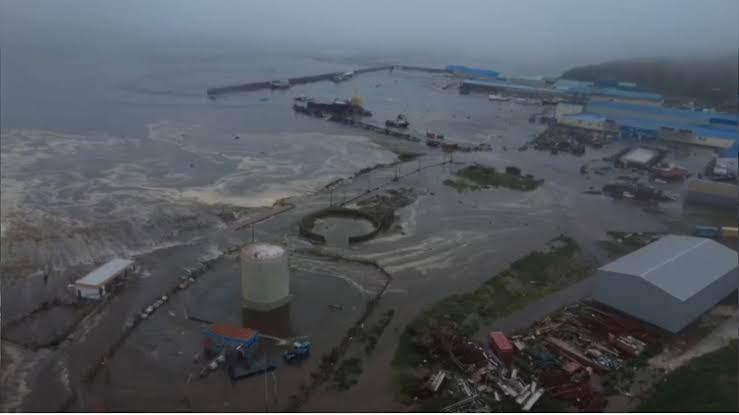National Times Bureau, July 30, 2025: A powerful 8.8 magnitude earthquake struck off the coast of Russia’s Far Eastern Kamchatka Peninsula early Wednesday, triggering tsunami waves up to 5 metres high and sparking widespread evacuation orders across the Pacific region, including in Japan, Hawaii, and other vulnerable coastal areas.
The earthquake, described by Russian scientists as the strongest in the region since 1952, caused damage to buildings and injured several people in Kamchatka. Waves from the undersea quake struck Severo-Kurilsk, flooding its port, dislodging ships, and damaging a fish processing facility, though no fatalities have been reported.
The U.S. Geological Survey reported that the quake was shallow, occurring at a depth of 19.3 kilometers, and was centered 119 kilometers southeast of Petropavlovsk-Kamchatsky, a city with a population of about 165,000. Residents there described prolonged and terrifying tremors, with one eyewitness saying, “It felt like the walls could collapse any moment.”
In response, Hawaii’s emergency authorities issued urgent evacuation orders, warning residents to move to higher ground or upper floors. Flights in and out of Maui were cancelled, though the Pacific Tsunami Warning Center later reported only minor waves reaching the Hawaiian islands.
Japan, still scarred by the devastating 2011 tsunami, ordered evacuations across its eastern coast, including Hokkaido. The government reported three tsunami waves hitting the country, the largest measuring 1.3 metres. Nuclear facilities, including the Fukushima plant, were evacuated as a precaution. Japan’s Chief Cabinet Secretary Yoshimasa Hayashi confirmed no casualties or irregularities at the country’s nuclear plants.
Across the Pacific, emergency services in the U.S. West Coast, Ecuador, Chile, and the Solomon Islands were put on high alert. The U.S. Tsunami Warning System warned of hazardous waves exceeding three metres in Russia and northern Hawaii, and between one to three metres in several other nations. Smaller waves could impact vast stretches of the Pacific, including Alaska and the continental U.S. coastline.
Russian authorities confirmed damage to public infrastructure, including a kindergarten, and advised residents to avoid gas appliances until inspections could be completed. Power outages were reported in Sakhalin due to damage to the grid. Emergency officials noted that many buildings in Kamchatka had withstood the tremors, thanks to updated structural standards.
The mayor of Severo-Kurilsk reported that the area had been hit by four tsunami waves, with the largest estimated at five metres. Authorities urged caution due to the potential for aftershocks and residual flooding.
The Kamchatka Peninsula and the Kuril Islands lie along the seismically volatile Pacific Ring of Fire, known for frequent earthquakes and volcanic eruptions. The Russian Academy of Sciences reiterated that although the quake’s magnitude was high, the ground shaking intensity was mitigated by the characteristics of the quake’s epicentre. Aftershocks continued to be felt, with some reaching up to 6.9 in magnitude.
U.S. President Donald Trump addressed the incident on social media, confirming ongoing tsunami warnings for Hawaii and watches for Alaska and the Pacific Coast. The situation remains fluid, with disaster response agencies across several countries monitoring wave patterns and preparing for potential aftershocks and secondary hazards.
Massive 8.8 Magnitude Earthquake Off Russia’s Kamchatka Triggers Pacific-Wide Tsunami Alerts

